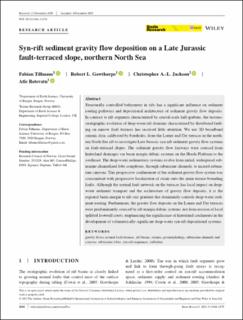Syn-rift sediment gravity flow deposition on a Late Jurassic fault-terraced slope, northern North Sea
Journal article, Peer reviewed
Published version

View/
Date
2021Metadata
Show full item recordCollections
- Department of Earth Science [1050]
- Registrations from Cristin [9791]
Abstract
Structurally controlled bathymetry in rifts has a significant influence on sediment routing pathways and depositional architecture of sediment gravity flow deposits. In contrast to rift segments characterized by crustal-scale half-grabens, the tectono-stratigraphic evolution of deep-water rift domains characterised by distributed faulting on narrow fault terraces has received little attention. We use 3D broadband seismic data, calibrated by boreholes, from the Lomre and Uer terraces in the northern North Sea rift to investigate Late Jurassic syn-rift sediment gravity flow systems on fault-terraced slopes. The sediment gravity flow fairways were sourced from hinterland drainages via basin margin deltaic systems on the Horda Platform to the southeast. The deep-water sedimentary systems evolve from initial, widespread submarine channelized lobe complexes, through submarine channels, to incised submarine canyons. This progressive confinement of the sediment gravity flow system was concomitant with progressive localization of strain onto the main terrace-bounding faults. Although the normal fault network on the terraces has local impact on deep-water sediment transport and the architecture of gravity flow deposits, it is the regional basin margin to rift axis gradient that dominantly controls deep-water sediment routing. Furthermore, the gravity flow deposits on the Lomre and Uer terraces were predominantly sourced by rift margin deltaic systems, not from erosion of local uplifted footwall crests, emphasising the significance of hinterland catchments in the development of volumetrically significant deep-water syn-rift depositional systems.
